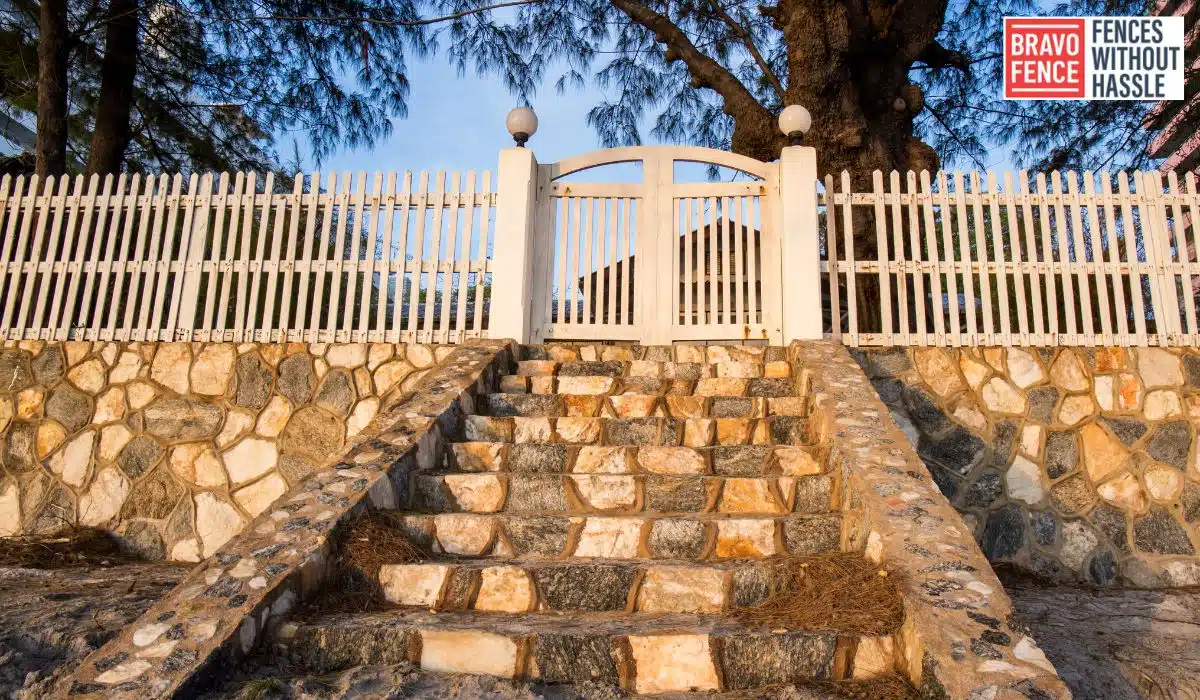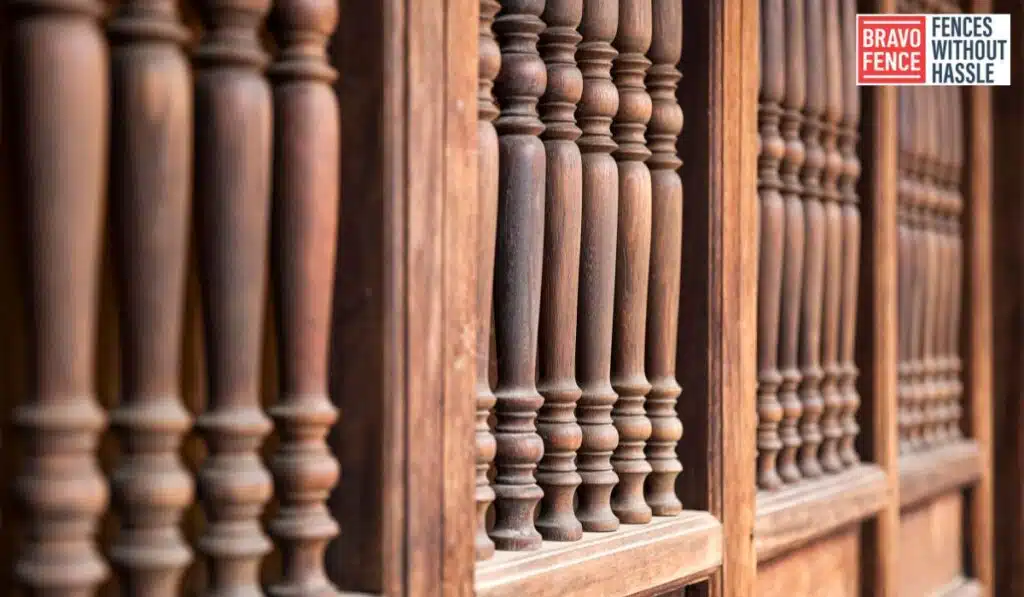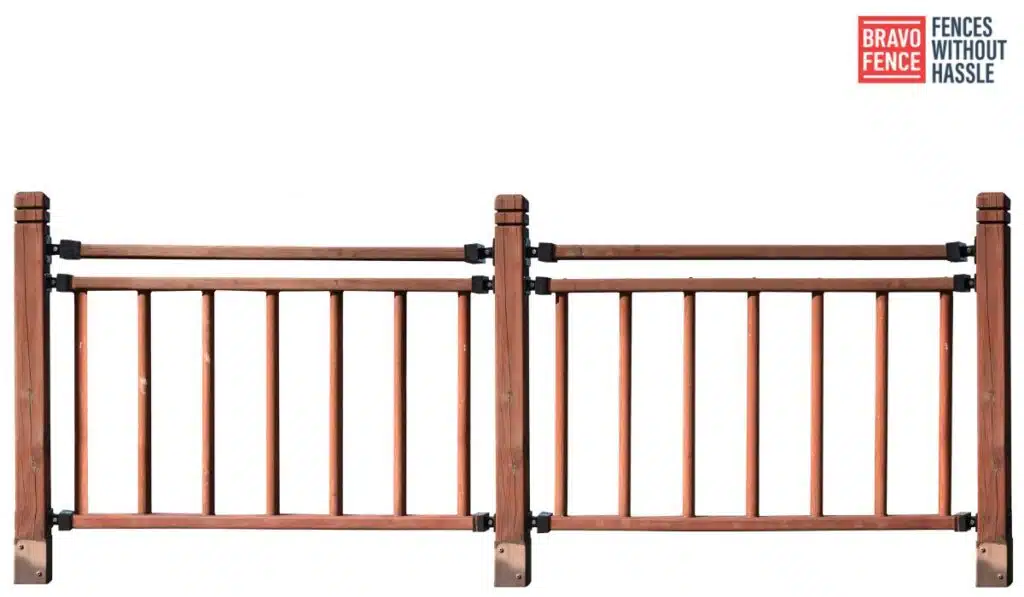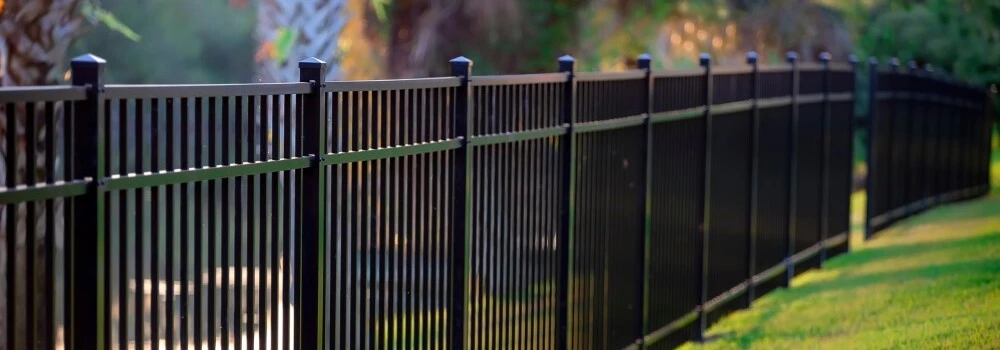
Which Wood Fence Gate Design Suits Your Style? Let’s Find Out
A wooden fence gate is not just a functional element; it also adds aesthetic appeal to your outdoor space. Choosing the right gate design can enhance your property’s look and feel. This article will explore various wood fence gate designs and provide valuable insights to help you make an informed decision.
Why Choose a Wooden Gate For Your Fence?
Wooden gates have been a popular choice for fences for centuries, and with good reason. Here are a few reasons why you should consider a wooden gate for your wall:
- Natural Beauty: Wood has a timeless appeal that can effortlessly blend with any landscape or architectural style.
- Versatility: Wood can be easily customized and crafted into different designs, allowing you to find a gate that suits your style and complements the overall aesthetics of your property.
- Durability: With proper maintenance and treatment, wooden gates can withstand time and weather conditions, making them a long-lasting investment.
- Eco-Friendly: Wood is a continuous resource, making it an environmentally-friendly choice compared to other materials.
Factors To Consider When Designing A Wood Fence Gate
Designing a wood fence gate requires careful consideration of various factors to ensure functionality, security, and visual appeal. Here are some key factors you should keep in mind:
- Gate Purpose: Determine the primary purpose of your gate. Is it meant for privacy, security, or to enhance the overall aesthetics of your property?
- Gate Size: Measure the opening where the gate will be installed and consider the size requirements for easy access and functionality.
- Gate Style: Choose a gate style that complements the design of your fence and aligns with your personal preferences. Popular options include picket gates, lattice gates, and arched gates.
- Hardware Selection: Select sturdy and high-quality hinges, latches, and handles that provide security and ease of use.
- Maintenance: Consider the requirements of different wood types and finishes to ensure your gate stays in good condition over time.
Tips To Help You Design A Functional And Effective Wood Gate
Designing a wood gate requires careful planning and attention to detail. Here are some valuable tips to help you create a functional and practical wood gate:
- Proper Measurements: Accurate measurements are crucial to ensure a well-fitting entrance. Measure the opening carefully, allowing for adequate clearance.
- Choose the Right Wood: Select a wood species that suit your climate and provides the desired durability. Cedar, redwood, and pressure-treated pine are popular due to their resistance to rot and insects.
- Gate Reinforcement: Incorporate structural reinforcements such as diagonal bracing or metal frames to prevent sagging and increase the gate’s stability.
- Seal and Protect: Apply a high-quality wood sealer or stain to protect your entrance from moisture, UV rays, and other environmental factors. Regularly inspect and reapply the protective finish as needed.
- Consider Automation: If convenience is a priority, you can explore options for automating your wood fence gate, such as installing an electric gate opener.

Some Of The Best Wooden Fence Gate Ideas To Consider
When it comes to wood fence gate designs, the possibilities are endless. Here are a few ideas to inspire you:
- Classic Picket Gate: This timeless design features evenly spaced pickets and a simple yet elegant look.
- Arched Gate: Add a touch of sophistication with an arched top, creating a graceful and inviting entrance to your property.
- Lattice Gate: Incorporate decorative lattice panels for a charming and visually appealing gate design.
- Rustic Split-Rail Gate: Perfect for a country or farmhouse-style setting, a split-rail gate exudes a rustic and welcoming vibe.
- Vertical Slat Gate: Create a modern and contemporary look with vertically oriented slats that provide privacy while maintaining an open feel.
Remember, these are just a few examples to ignite your creativity. Mix & match different elements to create a unique gate design that reflects your style.
Elevate Your Outdoor Space With A Well-Designed Wood Fence Gate
A well-designed wood fence gate can be a focal point in your outdoor space, adding charm and character to your property. By considering the factors mentioned above and exploring various design ideas, you can create a gate that perfectly complements your fence and enhances the overall aesthetics of your outdoor area.
Whether you prefer a traditional, rustic & contemporary style, wood fence gates offer versatility, durability, and natural beauty. With proper planning, craftsmanship, and regular maintenance, your wood gate will stand the test of time while impressing visitors and providing security for your property.
Invest in a well-designed wood fence gate today to elevate your outdoor space and create a warm welcome!
How do you stop a wooden gate banging in the wind?
A wooden gate can often create a loud banging noise when it repeatedly swings back and forth in the wind. To prevent this issue, consider the following solutions:
- Gate Stopper: Install a gate stopper or bumper when the gate reaches its fully open position. This will prevent the entrance from swinging too far and banging against the fence or adjacent structure.
- Adjust Hinge Tension: Check the gate’s hinges and ensure they are correctly adjusted. If the hinges are loose or too tight, it can cause excessive swinging and banging. Adjust the tension on the hinges to achieve a smooth swinging motion without excessive movement in the wind.
- Windbreakers: Install windbreakers or wind-resistant fencing materials around the gate area. These can help reduce the impact of strong winds on the gate, minimizing the swinging and banging.
- Gate Latch: Ensure that the gate latch is securely fastened when closed. A loose or poorly latched gate can swing open in the wind, creating banging noises. Double-check the latch and make any necessary adjustments or replacements.
- Gate Closer: Consider installing a gate closer mechanism that automatically closes the gate after it has been opened. This can prevent the entrance from swinging back and forth in the wind and reduce the chances of it banging against other structures.
By implementing these solutions, you can minimize the noise and disturbance caused by a wooden gate banging in the wind, ensuring a quieter and more peaceful outdoor environment.
How do you waterproof a wooden gate?
Properly waterproofing a wooden gate protects it from moisture damage, rot, and decay. Follow these steps to waterproof your wooden gate effectively:
- Clean the Surface: Clean the gate surface to remove dirt, debris, and existing finishes. Use a mild detergent, water solution, and a scrub brush or sponge to clean the wood gently. Rinse thoroughly & allow it to dry completely.
- Sand the Surface: Once the gate is dry, use fine-grit sandpaper to smooth the surface & remove any rough areas or imperfections. Sanding helps the waterproofing product adhere better to the wood.
- Apply Wood Sealer: Choose a high-quality wood sealer or waterproofing product for exterior use. Try the sealer evenly to the entire surface of the gate using a brush, roller, or sprayer. Follow the instructions regarding the number of coats & drying times.
- Pay Attention to Joints and Edges: Ensure that the sealer is applied to all joints, edges, and crevices of the gate, as these areas are more prone to moisture penetration. Apply an extra coat or focus on these areas to provide enhanced protection.
- Allow Sufficient Drying Time: After applying the sealer, allow the gate to dry thoroughly according to the product instructions. This drying process ensures the wood is adequately protected, and the sealer forms a waterproof barrier.
- Regular Maintenance: Periodically inspect the gate for signs of wear or damage. Touch up any areas where the sealer may have worn off or reapply a new coat of sealer as needed. Regular preservation will help prolong the life of the gate and maintain its waterproofing properties.
Conclusion
A wood fence gate can significantly enhance the appearance and functionality of your outdoor space. By carefully considering the design, factors, and tips mentioned in this topic, you can create a wood gate that perfectly complements your fence and reflects your style. Remember to choose suitable wood, incorporate sturdy hardware, and prioritize regular maintenance to ensure the longevity of your gate.
Investing in a well-designed wood fence gate will elevate your property’s curb appeal and provide security and privacy for your home. Embrace wood’s natural beauty and versatility to create an inviting entrance that sets the tone for your outdoor space.
FAQs
What are the disadvantages of wooden gates?
Wooden gates, while visually appealing and versatile, do have some disadvantages. These include:
- Maintenance Requirements: Wooden gates require regular maintenance, including staining or painting and sealing, to protect them from moisture, rot, and insects.
- Prone to Warping: Wood is susceptible to warping over time, especially if not properly treated and sealed.
- Not Suitable for All Climates: Wood may be more prone to rotting in extraordinarily wet or humid climates, requiring additional precautions and maintenance.
How big should a wood fence gate be?
The size of a wood fence gate depends on various factors, including the intended use and the dimensions of the opening. As a general guideline, a single gate should be at least 3 feet wide to accommodate easy access for individuals. A wider gate, such as 5 or 6 feet, may be more appropriate for more oversized items or equipment.
What is the max width of a wood fence gate?
The maximum width of a wood fence gate depends on the type of wood used, the design of the gate, and the structural reinforcement incorporated. Generally, single wood fence gates typically range from 3 to 6 feet in width. A double gate design or additional structural support may be necessary for wider openings.
Should a wooden gate open in or out?
Wood gates can open inward or outward, depending on space availability, convenience, and personal preference. Inward-opening gates are more common as they require less clearance space and are generally easier to open inside the property. However, outward-opening gates can offer additional security benefits and may be preferred in certain situations.

How far apart should fence posts be for a gate?
The spacing of fence posts for a gate depends on the width and weight of the gate, as well as the type of wood used and local building codes. As a general guideline, fence posts for a gate should be placed approximately 6 to 8 feet apart to provide adequate support and prevent sagging. However, closer spacing or additional reinforcement may be necessary for broader or heavier gates.
Should a fence gate swing in or out?
The direction in which a fence gate swings depends on several factors, including personal preference, space availability, and functionality. Inward-swinging gates are more common as they require less clearance space and are typically easier to open inside the property. However, outward-swinging gates can provide additional security benefits and may be preferred in certain situations.
What is the spacing for a wooden gate?
The spacing for a wooden gate depends on the desired level of privacy and airflow. If you prefer a more open feel, leave small gaps between the vertical slats of the gate. Alternatively, for increased privacy, you can position the slats closer together. Maintaining structural integrity while considering the aesthetic and functional aspects of the gate design is essential.
How wide should a gate be compared to the opening?
A gate should be slightly narrower than the opening to allow smooth operation and clearance. As a general guideline, aim for a gate width of approximately 1 inch less than the total opening width. This allows for adequate space for the gate to swing freely without scraping against the adjacent structure or obstructing the opening.
What is the best wood for a gate frame?
When selecting wood for a gate frame, choosing a durable and sturdy species that can withstand the elements and provide structural integrity is crucial. Common choices for gate frames include cedar, redwood, and pressure-treated pine. These woods are naturally resistant to rot & insects, making them suitable for outdoor applications.
What are the best joints for a wooden gate?
The joints used in a wooden gate play a critical role in its overall strength and stability. Some commonly used joints for gate construction include mortise and tenon joints, half-lap joints, and dovetail joints. These joints provide strong connections between the gate components and help prevent sagging or warping over time.
What makes wooden gates sag?
Wooden gates can sag over time due to various factors, including the weight of the gate itself, weather conditions, and inadequate structural reinforcement. More bracing or lack of diagonal supports can contribute to sagging. Additionally, moisture absorption by the wood and insufficient sealing or finishing can weaken the gate’s structural integrity.
How do you keep a wooden gate from sagging?
To prevent wooden gate sagging, consider the following measures:
- Proper Structural Reinforcement: Incorporate diagonal bracing or metal frames into the gate design to provide additional support and to avoid sagging.
- Regular Maintenance: Apply a high-quality wood sealer or stain to protect the gate from moisture, which can lead to warping and sagging.
- Correct Installation: Ensure the gate is installed correctly, with a secure attachment to the fence posts and a level position.
How do you make a wooden gate more secure?
To enhance the security of a wooden gate, you can take several measures:
- Sturdy Hardware: Install high-quality hinges, latches, and locks that are resistant to tampering and provide adequate security.
- Solid Construction: Use thick and sturdy wood for the gate frame and avoid designs with excessive gaps or weak points.
- Proper Installation: Ensure that the gate is securely attached to the fence posts and that there are no gaps or spaces through which someone could enter.
- Additional Security Measures: Consider installing a gate alarm system, motion sensor lights, or surveillance cameras to deter trespassers and enhance security.
Remember that while these measures can improve the security of a wooden gate, every gate is entirely impenetrable. It’s essential to assess your specific security needs and consider additional security measures for your property.
Tags: Complete Guide to Wood Fence Gate Design Ideas, Everything You Need to Know About Gate Ideas For Wood Fence, Everything You Need to Know About Wood Fence Door Ideas, Explore Helpful Resources on Wood Gate Fence Ideas, Explore Helpful Resources on Wood Privacy Fence Gate Ideas, Inspiration and Tips on Simple Wood Fence Gate Designs, Inspiration and Tips on Wood Fence And Gate Designs, Inspiration and Tips on Wood Fence And Gate Ideas, Top Ideas and Insights About Wood Fence Doors Ideas, Top Ideas and Insights About Wood Fence Gate Ideas, Top Ideas and Insights About Wood Fence Gates Ideas
